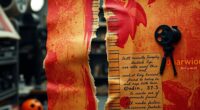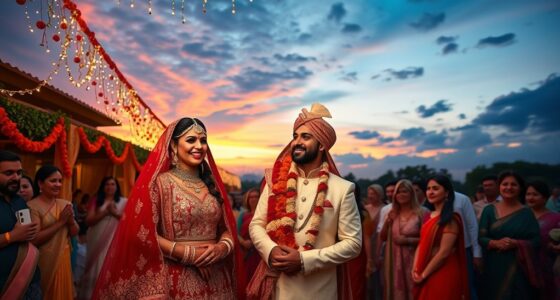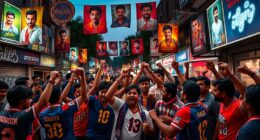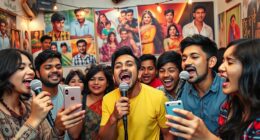In Bollywood, iconic shots and techniques make scenes visually striking and emotionally powerful. You’ll notice how vibrant color grading sets the mood, from romantic warm tones to intense cooler hues. Camera angles like high and low shots add drama and impact, while dynamic movements heighten energy. These techniques work together to craft memorable visuals that keep you engaged. If you continue exploring, you’ll discover how these elements seamlessly blend to create Bollywood’s signature cinematic magic.
Key Takeaways
- Bollywood cinematography employs vibrant color grading to set moods and enhance visual storytelling.
- Iconic shots often combine dynamic camera angles with strategic color adjustments for emotional impact.
- Wide shots and close-ups are used to highlight grandeur, intimacy, and character emotions effectively.
- Color palettes like warm hues or cool tones reinforce themes such as romance or tension.
- The integration of camera angles and color grading elevates Bollywood films into visually captivating spectacles.
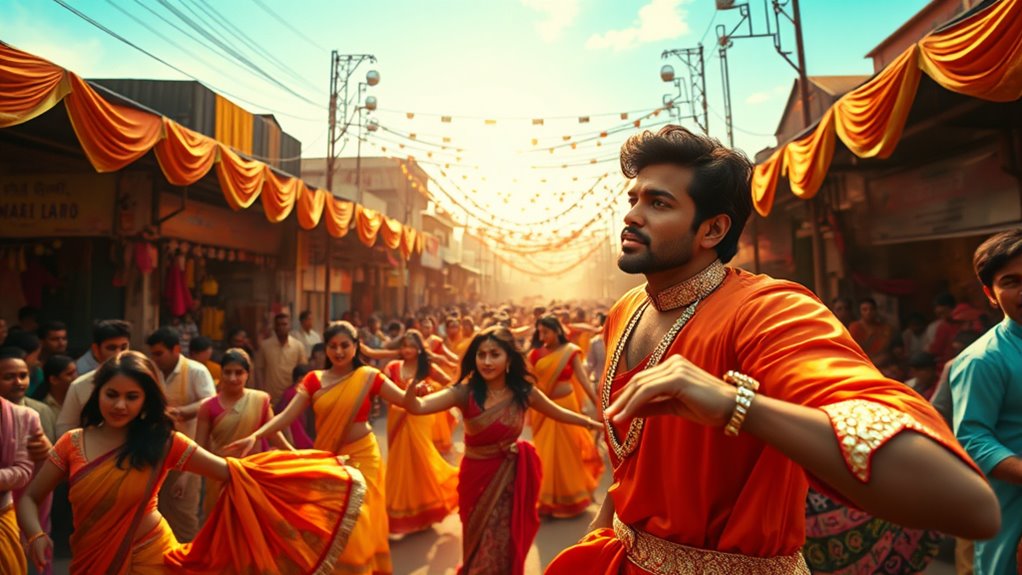
Have you ever wondered how Bollywood films create such vibrant and mesmerizing visuals? The secret lies in a combination of expert color grading and strategic camera angles that work together to evoke emotion and capture the audience’s attention. Color grading is vital in setting the mood of a scene; it enhances the visual tone and brings out the richness of the colors, making every frame pop with life. Whether it’s the warm hues during romantic moments or cooler tones during tense sequences, skilled color grading transforms raw footage into a captivating visual experience. Camera angles also play an essential role, as they influence how you perceive the story and characters. Directors and cinematographers often experiment with high angles to create a sense of dominance or vulnerability, low angles to make characters seem powerful, or sweeping wide shots to showcase breathtaking landscapes. These choices aren’t random—they’re deliberate techniques designed to reinforce the narrative and emotional stakes.
Expert color grading and strategic camera angles craft Bollywood’s vibrant, emotionally charged visuals.
In Bollywood, you’ll notice how dynamic camera angles heighten the energy of dance sequences and musical numbers. Fast-paced shots from different angles keep you engaged, emphasizing the rhythm and movement of the performers. Close-up shots are used to capture the raw emotion on actors’ faces, pulling you deeper into their experience. Meanwhile, long shots often frame entire ensembles, highlighting the grandeur of elaborate sets and choreography. This variety ensures that each scene feels visually interesting and emotionally resonant, guiding your focus where it needs to be. Additionally, the use of color grading plays a crucial role in supporting these visual choices by meticulously adjusting hues, saturation, and contrast to evoke specific moods and themes.
Color grading also complements these camera angles by enhancing the overall aesthetic. For instance, a romantic duet might feature soft, pastel tones to evoke tenderness, while a high-octane chase scene could be tinted with darker, more saturated colors to heighten suspense. The contrast and saturation levels are carefully adjusted during post-production to guarantee that each visual element supports the story’s mood. When you watch a Bollywood film, it’s clear that these techniques aren’t just technical choices—they’re storytelling tools. The masterful use of color grading and camera angles creates iconic shots that linger in your memory, making the cinematic experience both immersive and emotionally impactful.
Together, these elements showcase the artistry behind Bollywood’s visual storytelling. They demonstrate how thoughtful cinematography elevates a film from mere entertainment to a captivating spectacle. Whether it’s a tender love scene or an adrenaline-fueled action sequence, the skillful application of color grading and camera angles ensures that every frame serves a purpose, drawing you into a vibrant world of colors, movement, and emotion.
Frequently Asked Questions
Which Bollywood Films Pioneered Innovative Cinematography Techniques?
You should check out “Dilwale Dulhania Le Jayenge” for pioneering visual effects and innovative camera angles that set new standards. “Koi… Mil Gaya” also stands out, showcasing groundbreaking visual effects that enhanced storytelling. These films pushed Bollywood’s boundaries, demonstrating how creative cinematography techniques can elevate emotional impact and visual appeal, inspiring future filmmakers to experiment with new styles and technologies in their craft.
How Do Cinematographers Collaborate With Directors in Bollywood?
You collaborate closely with directors, crafting a cohesive visual story through constant communication. By sharing your creative vision, you align your artistic ambitions with their storytelling goals. You translate ideas into technical execution, balancing beauty and functionality. Regular discussions, brainstorming sessions, and feedback loops ensure your cinematography complements the narrative. Together, you create compelling, enthralling visuals that elevate the film’s emotional impact, blending creativity with technical precision seamlessly.
What Equipment Is Commonly Used in Bollywood Cinematography?
In Bollywood cinematography, you typically use camera rigs like Steadicams and Dollies for smooth shots, along with drones for aerial views. Lighting setups often include softboxes, reflectors, and LED panels to create dramatic or romantic effects. You choose equipment based on the scene’s mood, ensuring shots are vibrant and dynamic. This combination of camera rigs and lighting setups helps you craft visually stunning sequences that captivate audiences.
How Has Digital Technology Transformed Bollywood Cinematography?
Digital technology has revolutionized Bollywood cinematography, turning your films into vibrant canvases. You now harness digital color grading to craft moods and enhance visuals with striking precision. Drone aerial shots lift your camera into the sky, offering sweeping perspectives that were once impossible. This transformation makes your storytelling more immersive, allowing you to paint scenes with digital brushstrokes that captivate audiences and elevate Bollywood’s visual artistry to new heights.
Who Are the Most Influential Bollywood Cinematographers of All Time?
You should definitely know about Rajan Kinagi and S. Kumar, who are some of the most influential Bollywood cinematographers. They’ve created legendary visuals with their signature styles—Kinigis’ vibrant color palettes and Kumar’s dramatic lighting. Their innovative techniques have shaped Bollywood’s visual storytelling, inspiring countless filmmakers. By studying their work, you’ll gain insight into how cinematography elevates narratives and creates iconic moments that define Bollywood’s cinematic legacy.
Conclusion
As you’ve seen, Bollywood’s cinematography weaves magic like a vibrant tapestry, blending iconic shots and inventive techniques. Every frame dances with emotion, capturing hearts and dreams in a kaleidoscope of colors. With each shot, you’re pulled into a world where visuals sing and stories breathe through the lens. Remember, it’s not just film; it’s a symphony of light and motion, forever echoing the soul of Bollywood’s timeless charm.
